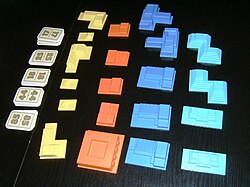Metropolis (game)
| Metropolis | |
|---|---|
 Metropolis accessories (building) |
|
| Game data | |
| author | Sid Sackson |
| publishing company | Ravensburger |
| Publishing year | 1984 |
| Art | Strategy & luck |
| Teammates | 2 to 5 |
| Duration | 45 - 60 minutes |
| Age | from 16 years
|
| Awards | |
|
Game of the Year : Shortlist 1984 |
|
Metropolis is the name of a board game by Sid Sackson that was published by Otto Maier Verlag Ravensburg in 1984 and made it onto the selection list for Game of the Year . In this game, chance and strategy are in balance.
material
In addition to a game board and 80 small property cards, the game contains 25 differently colored and differently sized buildings (houses, schools, shops etc.) as well as 6 scoring tables and 140 plastic chips in 5 colors.
Objective and course of the game
Buildings are gradually erected on the game board with lots after the lots have been distributed in a kind of lottery procedure . Depending on which buildings are being built on the neighboring properties, the buildings lose or gain in value. Whoever achieves the highest rating of his buildings in the end is the winner. Without a certain amount of cooperation between the individual players, however, you cannot create a city that is suitable for living and in which quality of life should play a role.
regulate
At the beginning, plot cards are distributed depending on the number of players and the owners mark these spots on the board with a chip of their color. The rest of the cards are placed next to the game board, with 4 cards revealed so everyone knows which lots to purchase next. Using the rating table, each player can see the value of his land and the buildings that may be built on it. A house with a view of the park and by the river is much more valuable than a house near a factory; a shop in the center brings in more than on the outskirts of town etc.
In turn, everyone can now acquire a new piece of land and build on it, provided the shape matches and the building is still there (the rule is: first come, build first!). When choosing the property, however, a so-called neighbor law applies . While plots without neighbors can be acquired by anyone, plots with one neighbor can only be taken by this neighbor, with two or more neighbors all can, depending on the order.
The players can negotiate with one another at any time and swap properties or realize a joint construction project. When building, the chip is simply removed from the property, the building is inserted appropriately and a chip is placed on the part to identify the owner.
Playing
The game ends when no more buildings can be erected, either because there are no more components or the other buildings no longer fit on the plots. The value is now determined for each building using the table and credited to the owner (or several; the department store can only be built in groups). The one with the highest total is the winner. The highest attainable number of points seems to be 304.
Web links
- Metropolis in the Luding games database
- Metropolis in the board game database BoardGameGeek (English)